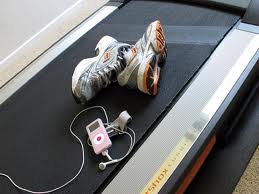By
Susan Gernhart on March 22nd, 2011
 Gearing up for your first 5K, 10K, Half Marathon or Full Marathon? Congratulations!
Gearing up for your first 5K, 10K, Half Marathon or Full Marathon? Congratulations!
With lots of great races scheduled nationwide, I went directly to the pros for tips and guidelines on how to stay focused, build stamina and meet (or exceed!) your goals. And since running requires both physical and mental exertion, we’ve got you covered in both categories for each distance.
Good luck and don’t forget to share any of your tips, tricks and words of wisdom with us on how to best reach that finish line!
5K – Physical Preparation
Steve Dunn – Marathon Runner, participant in 100+ races of all distances, and Owner of specialty store Hit the Trails (www.hitthetrails.com).
• For those who are literally just getting off their couches and have never run before, it’s important to slowly transition from walking to jogging to running. Take at least a month to start slow and build your way up to a faster pace.
• Once you have reached a runner’s pace, mix up track runs (short distances such as 200’s and 400’s) along with tempo runs (mile warm up, a few miles at race followed by a cool down).
• Although a 5K is 3.1 miles, try to run 4 or 5 miles to build up your endurance
• On the day of the race, be prepared with a water belt if needed and concentrate on both your pace and breathing. People often get distracted which (unintentionally) shaves minutes off their time because they don’t run as hard when they lose focus.
5K – Mental Preparation
Carrie Chealde, M.A., CC-AASP – Mental Skills Coaching for Athletes (www.carriecheadle.com; www.facebook.com/MentalSkillsTrainingforAthletes).
• Schedule your training in your calendar. Treat it like you would any other important appointment; otherwise, it’s likely to get pushed further and further back in the day until it gets pushed out altogether!
• Find a buddy to get your runs in with. Not only will it make the time pass more quickly, but you’re much less likely to flake on your run when you are meeting up with someone else.
• Athletic Gear – Having the proper attire is essential not only physical reasons, but for mental reasons as well. Having gear that makes you feel athletic will help you feel more inspired to run. When you look the part, you feel the part!
10K – Physical Preparation
Paul Dziewisz is a NASM and CrossFit Level 1 Certified Personal Trainer and owner of Active Personal Fitness in Doylestown, PA (www.ActivePersonalFitness.com).
Distance running is demanding on the body. An emphasis on cross-training improves cardio capacity and helps prevent injury. Plus it eliminates the boredom for running 4 days a week. My approach to training for a 10K places more focus on cross-training to improve your long-distance endurance.
• Progressively build your distance capability with one long run per week starting at 1-2 miles and increasing gradually to 6 miles.
• Supplement the long runs with 3-4 moderate-duration, high-intensity workouts. This will build the endurance and physical strength need to excel and stay free of injury.
• Utilize a circuit training approach, perform total body exercises and eliminate rest time from your workouts.
• Consciously push yourself to perform the workouts with greater intensity each time.
10K – Mental Preparation
Cori Bank, Ph.D. – Sports Psychologist and Ironman Triathlon Finisher. His website offers free monthly videos on exercise tips and peak performance (www.abingtonpsychology.com).
• It’s psychologically beneficial to treat those last two weeks (prior to the race) as if you were running the ‘real thing’. Have a complete checklist and include all aspects – your pre-race meal and drinks, what music you want on your Ipod, your stretches and warm-ups, etc.
• By incorporating all the elements of the big day, you’ll have perfected your physical and mental dress rehearsal and your confidence will be skyrocketing.
• On race day, start towards the back. It’s natural to want to be with the runners at the front of the pack, but it can demoralizing and discouraging to have all of the faster runners pass you. Start a few rows back and soon you’ll be the one passing people as the race goes on.
• Treat the race as you would a huge exam. You wouldn’t study for a major test all at once. To avoid mental fatigue, break the race up into smaller chunks as well. Instead of thinking of it as an intimidating 6.2 miles, visualize it as six one-mile mini events and focus on just one at a time.
• With that said, some people even have a theme per mile (i.e. Mile One = warm up, Mile 2 = stride count, Mile 3 = refueling, and so on.)
• Once you feel in control, you feel empowered. Once you feel empowered, you can reach your potential. Once you reach your potential, you allow yourself to experience an event over again and share it with others!
Half Marathon – Physical Preparation
Jason Fitzgerald is a coach and author of Strength Running, which helps runners transform their training (www.strengthrunning.com).
• Racing a half-marathon relies almost exclusively on your endurance, so prepare with one weekly long run in the 11-13 mile range.
• In addition to your long run, consistently run 3-4 days each week to build that endurance.
• In addition to building your stamina, a gym session twice a week can help prevent injury. Concentrate on multi-joint exercises that train movements (not muscles), such as squats, pull ups, bench press, dead lifts, dips, and lunges.
• Longer runs and more total running will have you performing faster on race day. As a beginner, interval training isn’t necessary yet, but 1-2 minute surges during your easy runs can help you develop more speed without overtaxing you. Take as much jogging recovery in between as you want.
Half Marathon – Mental Preparation
Keri Cawthorne, running coach and owner of Iron Mountain Movement (www.ironmountainmovement.com).
• Long runs are best with company. Run with a local running group, buddy or music, the time will pass much more quickly.
• The week before the race, ignore psychosomatic aches and pains, your body is just telling you it is ready to run.
• If possible, drive the race route before and visualize yourself crossing the finish line.
• Find your mantra, something to keep you calm and focused during the race , whether it’s ‘Just Do it’ or ‘Finish Strong’. For the Vegas Marathon I used ‘Don’t Think, Just Run’!
Full Marathon – Physical Preparation
Tom Holland is an exercise physiologist and sports performance coach. Author of The Marathon Method, The 12-Week Triathlete and Beat the Gym, Tom is a sub-3 hour marathoner and has completed over 50 marathons and 18 Ironman triathlons. (www.teamholland.com).
• Be sure to include at least one day of strength training per week into your program. Two is best.
• 4 Great Weekly Running Workouts: Hills, Endurance, Speed and Tempo runs
• You need one rest day per week. No exercise.
• Core strength is essential to running performance as well as injury prevention.
• Refuel after runs with carbohydrate and some protein, ideally within 30 minutes.
• Practice running negative splits. For example, for a ten-mile run, run five miles out, then come home slightly faster.
• Try to do one cross-training workout per week such as cycling, swimming, or the StairMaster.
• You need “down” weeks during training. For example, in a four week cycle, you may run 25 miles, 30 miles, 35 miles, then on the fourth week, drop down to 20-25 miles or so to recover as well as to prepare for the next block.
• Be sure to taper for at least 2-4 weeks before your race.
• Try to make your training as close to race conditions as possible. What you wear, how you eat and drink, the course – all of these details count.
Full Marathon – Mental Preparation
Andrew Johnston – Author of the February 2011 release, ‘Holistic Strength Training for Triathlon’ (www.amazon.com/Holistic-Strength-Training-Triathlon-Johnston/dp/1456724037/ref=sr_1_1?ie=UTF8&s=books&qid=1298907034&sr=8-1) with proceeds benefitting the Leukemia & Lymphoma Society. Andrew is a former professional cyclist, the first leukemia survivor to qualify for and finish the Hawaii Ironman World Championships, and twice voted One of the Top Trainers in America by Men’s Health.
• The starting line can be the most intimidating part of the race, especially for first timers. You’re surrounded by all of these fit athletes, many of whom look like they’re either out for a morning stroll or fast enough to rip your legs off! Congratulate yourself for being there and remember that towing the line is an accomplishment and a blessing — there are millions who do not have the time, the motivation, or the health to ever even consider participating. Think of the race as a 26.2 mile parade celebrating your vitality and life!
• Write positive affirmations on your forearms. Words like “fast” or “smooth” or “strong” are then literally only an arm’s length away from getting back into your head if a negative thought breaks your concentration.
• Despite any rough patches, keep in mind that everyone is covering the same distance, using the same muscles, breathing the same air, fighting the same elements, and even struggling (at times) with the same thoughts. Focus on the now and not 10 miles up the road. Whatever you’re experiencing at the moment will pass, too — just like the road under your feet.
• Break the marathon up into specific milestones. After the first mile, I tell myself I’m one 1/26th of the way there. At the second mile, I’m 1/13th of the way there. Playing this game helps divide the marathon up into digestible pieces.
• Start slower than you think you should. It’s difficult to keep the ego in check when the gun goes off, but with the marathon, it’s not about who runs the fastest so much as who slows down the least. And catching people at the end is enough motivation to keep a smile on anyone’s face until the finish line.
 My name is Valerie Zink, and this is MY story. I was overweight since the 4rth grade. My parents were very poor while I was growing up, always struggling to make ends meet. Because of this, I ate A LOT of cheap processed foods. I would NEVER blame my parents for who I became; I am just explaining my lack of education when it came to food and being healthy. And I hated to exercise. I was the girl you always saw trailing at the end of EVERYTHING in gym class, yeah, you know the one. That was me.
My name is Valerie Zink, and this is MY story. I was overweight since the 4rth grade. My parents were very poor while I was growing up, always struggling to make ends meet. Because of this, I ate A LOT of cheap processed foods. I would NEVER blame my parents for who I became; I am just explaining my lack of education when it came to food and being healthy. And I hated to exercise. I was the girl you always saw trailing at the end of EVERYTHING in gym class, yeah, you know the one. That was me. One thing you will NEVER hear me say about my journey is that it was easy — It just wasn’t. This was a ton of hard work and dedication. BUT I believe that if I can do it, ANYONE can. You just have to truly believe in yourself, trust in God’s strength and know beyond a shadow of a doubt that you have the inner ability to do anything you put your mind to with His help. Everyone is strong enough. I really believe that 110%! I had my weeks where my weight went up, and then came back down. I hit plateaus. I struggled EVERY minute some days with what I was going to eat or whether or not to go work out. But I stayed focused. And determined. I made mistakes. But realized that I am only human, and bound to make a few. I just kept remembering part of my favorite quote, “Life is an ever-changing process, and nothing is final. Therefore, each moment and every day is a chance to begin anew.” And that is exactly what I did.
One thing you will NEVER hear me say about my journey is that it was easy — It just wasn’t. This was a ton of hard work and dedication. BUT I believe that if I can do it, ANYONE can. You just have to truly believe in yourself, trust in God’s strength and know beyond a shadow of a doubt that you have the inner ability to do anything you put your mind to with His help. Everyone is strong enough. I really believe that 110%! I had my weeks where my weight went up, and then came back down. I hit plateaus. I struggled EVERY minute some days with what I was going to eat or whether or not to go work out. But I stayed focused. And determined. I made mistakes. But realized that I am only human, and bound to make a few. I just kept remembering part of my favorite quote, “Life is an ever-changing process, and nothing is final. Therefore, each moment and every day is a chance to begin anew.” And that is exactly what I did. I was recently attacked by one of our facebook follower’s whose profile name is Patrick Galego. He claims that I am a fraud. He claims that I have lied to you all and that I am not who I say I am. My response is, “go fuck yourself!” Excuse my language. I usually don’t like to use curse words in my blogs but he deserved it. After he left this post on our facebook fan page, he looked sooooooo dumb that he decided to delete the post. So unfortunately I can’t post it here.
I was recently attacked by one of our facebook follower’s whose profile name is Patrick Galego. He claims that I am a fraud. He claims that I have lied to you all and that I am not who I say I am. My response is, “go fuck yourself!” Excuse my language. I usually don’t like to use curse words in my blogs but he deserved it. After he left this post on our facebook fan page, he looked sooooooo dumb that he decided to delete the post. So unfortunately I can’t post it here.

 You may have heard of The Flex Belt, the first ab belt approved by the Federal Drug Administration (FDA) for abdominal toning, or maybe you haven’t. I’ll be honest, I’ve heard of it before, but I never paid much attention to it. I was very skeptical of any thing that claimed to tone abdominal muscles without cutting sugars and carbs and without intense workouts.
You may have heard of The Flex Belt, the first ab belt approved by the Federal Drug Administration (FDA) for abdominal toning, or maybe you haven’t. I’ll be honest, I’ve heard of it before, but I never paid much attention to it. I was very skeptical of any thing that claimed to tone abdominal muscles without cutting sugars and carbs and without intense workouts.

 Gearing up for your first 5K, 10K, Half Marathon or Full Marathon? Congratulations!
Gearing up for your first 5K, 10K, Half Marathon or Full Marathon? Congratulations!  It’s just the 3 of us
It’s just the 3 of us If you want to get better results from your workouts, it’s important that you stay healthy. Your body is a well-oiled machine. Everything is connected. In order for you to lose fat and gain mass, your whole body needs to be functioning properly. And if you’re sick, this isn’t going to happen.
If you want to get better results from your workouts, it’s important that you stay healthy. Your body is a well-oiled machine. Everything is connected. In order for you to lose fat and gain mass, your whole body needs to be functioning properly. And if you’re sick, this isn’t going to happen. This passage of the Bible stood out to me today as I studied. Before the science of psychology was a thought, the Bible spoke about how our mind affects our body. If you look at all the studies done you will find how the mind and body affect each other. Doctor’s say that physical exercise releases something called endorphins which act as neurotransmitters through the body increasing energy and giving us a “Natural High”. These endorphins are also known to increase happiness. According to studies at Duke University 60% of a group they studied with depression, whom exercised 30 minutes 3 times a week, overcame their depression without any medication.
This passage of the Bible stood out to me today as I studied. Before the science of psychology was a thought, the Bible spoke about how our mind affects our body. If you look at all the studies done you will find how the mind and body affect each other. Doctor’s say that physical exercise releases something called endorphins which act as neurotransmitters through the body increasing energy and giving us a “Natural High”. These endorphins are also known to increase happiness. According to studies at Duke University 60% of a group they studied with depression, whom exercised 30 minutes 3 times a week, overcame their depression without any medication. A study must show that minding your own business is good for your health.
A study must show that minding your own business is good for your health.
 Have You Ever Thought About Hiring A Personal Trainer?
Have You Ever Thought About Hiring A Personal Trainer? Tom is a big man, and a big eater. I mean, this a man who eats six junior bacon cheese burgers and three orders of nuggets for lunch. Because of how extremely heavy he is, it’s hard for him to handle his weight. So at dinner time he would lay on his bed with a grill at the edge, he would watch TV as he cooked his steaks, and then he’d eat while lying on his gigantic belly. You could tell just by looking at the screen that he had to be killing himself, his organs must have been squeezing into nothing. In his own words he says, “I’m Lucky to still even be alive, because of all this weight. Life is more than eating. I feel like I wasted my life.”
Tom is a big man, and a big eater. I mean, this a man who eats six junior bacon cheese burgers and three orders of nuggets for lunch. Because of how extremely heavy he is, it’s hard for him to handle his weight. So at dinner time he would lay on his bed with a grill at the edge, he would watch TV as he cooked his steaks, and then he’d eat while lying on his gigantic belly. You could tell just by looking at the screen that he had to be killing himself, his organs must have been squeezing into nothing. In his own words he says, “I’m Lucky to still even be alive, because of all this weight. Life is more than eating. I feel like I wasted my life.” Jodi is a beautiful woman who is a former singer that has lost her drive because of her weight. She is a mother of two and has marital issues due to her athletic husband who is no longer willing to accept her after the weight gain. Jodi has already had a minor stroke at her young age. After hearing the bad news of how terrible her health has become she says “I don’t have a choice, it’s either do it or die, change or die. I want to fix it. I just want to just fix it.”
Jodi is a beautiful woman who is a former singer that has lost her drive because of her weight. She is a mother of two and has marital issues due to her athletic husband who is no longer willing to accept her after the weight gain. Jodi has already had a minor stroke at her young age. After hearing the bad news of how terrible her health has become she says “I don’t have a choice, it’s either do it or die, change or die. I want to fix it. I just want to just fix it.” How many times have we told ourselves that we want change? We tell ourselves we don’t want to be lazy anymore or that we don’t want to be fat and out of shape. We are tired of lounging around without purpose. We think about it and talk about it like it’s some sort of distant fantasy. Purpose or an active lifestyle doesn’t have to be a distant fantasy.
How many times have we told ourselves that we want change? We tell ourselves we don’t want to be lazy anymore or that we don’t want to be fat and out of shape. We are tired of lounging around without purpose. We think about it and talk about it like it’s some sort of distant fantasy. Purpose or an active lifestyle doesn’t have to be a distant fantasy. It was reported yesterday that Adam Sandler is seriously considering playing the role of a 800 lb morbidly obese man in a new movie tentatively titled Fat Man. In the movie he has a love affair with his nurse that helps him drop down to 600 lbs. Oh… and he’s also naked for the first half of the movie.
It was reported yesterday that Adam Sandler is seriously considering playing the role of a 800 lb morbidly obese man in a new movie tentatively titled Fat Man. In the movie he has a love affair with his nurse that helps him drop down to 600 lbs. Oh… and he’s also naked for the first half of the movie.  Artera said “I’d love to do a movie with Adam Sandler that… someone said he was flirting with? It’s called Fat Man. One of the main writers of The Simpsons wrote the script and it’s amazing.”
Artera said “I’d love to do a movie with Adam Sandler that… someone said he was flirting with? It’s called Fat Man. One of the main writers of The Simpsons wrote the script and it’s amazing.” Not only do I love to run, but I love the treadmill. A bit odd for someone who has self-diagnosed A.D.D., but it’s true; I find it easier to run on the treadmill versus the pavement. With colder weather right around the corner, most outdoor fans are forced to transition to indoor workouts. I know many LOATHE the big ‘T’ but here are a couple of tips on how to pass the time. Keep in mind that I have the attention span of a five-year-old.
Not only do I love to run, but I love the treadmill. A bit odd for someone who has self-diagnosed A.D.D., but it’s true; I find it easier to run on the treadmill versus the pavement. With colder weather right around the corner, most outdoor fans are forced to transition to indoor workouts. I know many LOATHE the big ‘T’ but here are a couple of tips on how to pass the time. Keep in mind that I have the attention span of a five-year-old.